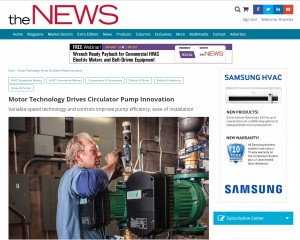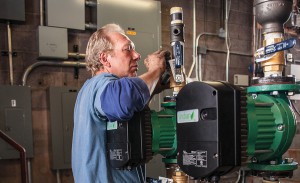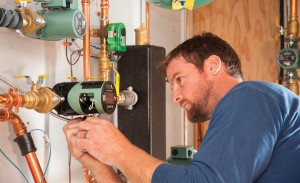 As seen on achrnews.com – December 7, 2015
As seen on achrnews.com – December 7, 2015
Variable-speed technology and controls improve pump efficiency, ease of installation
In hydronic heating and cooling systems, circulator pumps move water or refrigerant throughout a closed-loop system in order to transfer energy from the source to the point of need. While older circulator pumps utilized single-speed motors and were largely inefficient, advances in motor technology, controls, and pump design have transformed the market and ushered in a new era of highly efficient products that feature variable-speed motors, easy installation and setup, remote connectivity, and more.
 CIRCULATOR REVOLUTION: Advancements in motor technology, controls, and pump design have transformed the market and ushered in a new era of products that are smarter and more efficient than ever. Photo courtesy of Taco Inc.
CIRCULATOR REVOLUTION: Advancements in motor technology, controls, and pump design have transformed the market and ushered in a new era of products that are smarter and more efficient than ever. Photo courtesy of Taco Inc.

HYDRAULIC DESIGN IMPROVEMENTS
Circulator pumps have improved in numerous ways, including in hydraulic design, said Andy Januszewski, marketing manager for standard building products, Armstrong Fluid Technology.
“We continue to improve hydraulic efficiency,” he said. “You see CFD [computational fluid dynamics] tools in a lot of industries, such as automotive, getting more aerodynamic, and it’s the same in the pump world. Systems are now designed to ensure liquids flow very efficiently through the pumps, and that’s brought huge gains in efficiency.”
Small pumps have seen significant gains in efficiency due to improvements in design, he added.
“Some of the early ones ranged from 10-20 percent efficiency at the really small residential level, but, nowadays, you can get 60 percent efficiency out of those small ones — it’s significant.”
Jack Kang, product manager at Xylem Inc., parent company of Bell & Gossett, said aesthetics have also improved over the years. “Newer pumps have been designed to meet a level of aesthetics that make them more appealing to today’s users, oftentimes employing some of the same elements used in other technology industries, like consumer electronics,” he said.
Changes in design have also facilitated easier installation for the contractor. While vertical inline pumps are not “radically new,” they are gaining momentum as designers and contractors realize the benefit of not having to mount pumps in commercial applications, Januszewski said.
“People are just kind of realizing the benefits,” he said. “Traditionally, pumps were base-mounted on concrete pads on steel frames and required vibration isolation. The pumps Armstrong offers allow you to hang the pump from the piping in the building. They take up far less space and are easier and faster to install. Those kinds of innovations — thinking about the whole process of installation and operation — are important aspects, whether it’s making pumps easier to install or service or making them more energy efficient. There are innovations on all fronts that are hitting the market.”
THE RISE OF VARIABLE SPEED
While many manufacturers still offer product lines that utilize single-speed motors, variable-speed technology is quickly gaining momentum in pumps of all sizes — from 1/25 hp for residential applications to more than 1,250 hp for commercial and industrial applications. These improvements in motor technology have had a significant impact on the overall efficiency of circulator pumps.
“The circulator pump market has shifted toward a more energy-conscious model in the past few years,” Kang said. “Motor/drive technology has heavily influenced circulator pumps.”
Doug Bird, product manager at Taco Inc., said Taco began selling circulators with ECM technology in 2012 and now offers a broad range of circulators and pumps with the motors.
“Our wet-rotor ECM circulators use the latest permanent magnet motor technology,” he said. “They use up to 85 percent less electricity than a standard circulator, and the Delta-T technology makes the entire system run more efficiently, boosting total system savings by 15-19 times over electrical savings, alone. And, with the ability to determine the exact flow required to match ever-changing building heat loads, these circulators can reduce boiler short-cycling, increase total system efficiency, maximize energy savings, and improve consumer comfort.
Some of Taco’s products also utilize variable frequency drive (VFD) technology. “VFD’s permit the installer to accomplish easy, do-it-yourself system balancing for both constant-flow central plant applications and variable-flow building distribution applications,” Bird said.
BETTER MOTOR CONTROL
Recent advancements in motor controls have perhaps impacted the circulator pump market most of all.
Kirk Vigil, senior program manager, building services – Americas, Grundfos Pumps Corp., said that by including microprocessors to control ECM speeds, users have the capability of adding other functionality to circulators, like auto-learning modes, the ability to display and collect performance data, interactive human interfaces and controls, and wireless capabilities.
“Grundfos’ AUTOADAPT™, which is advanced software within microprocessors in the control head of the pump, uses internal sensors and advanced algorithms to monitor the actual changes in a heating or cooling system and continually controls the pump speed to satisfy the system demand,” Vigil said. “Not only is this very energy-efficient, saving both energy and fuel costs, but it also optimizes comfort.”
Advanced controls allow the pump to adjust output depending on the building’s or home’s current load, Januszewski said. “You rarely run [at design capacity] — maybe 2 percent of the time,” he said. “Most of your time is running at part-load capacity. So, the modern pumps — like the Design Envelope pumps, for example — will be able to throttle back the flow to what’s needed and match the building’s load to significantly reduce energy consumption while still providing the same level of comfort.”
“What started with relatively simple controls has now evolved to a deeper level with advanced software programs driving motor/pump operations in a system to optimize performance against the energy used,” Kang agreed. “Today’s circulator pumps often measure real-time results from the system and make adjustments via microprocessors to actively manage the systems in which they’re operating.”
THE SMART PUMP
Improvements in motor technology and controls have given birth to the “smart pump,” which Bird defines as “one that can sense changes in system conditions — any alteration in temperature or pressure — and change or adjust its own operation automatically to optimize system performance.”
An example of that would be Taco’s Delta-T pump, which quickly responds to any variation in supply and return temperatures, he said. “If, for instance, a winter storm caused greater temperature loss on one side of the home — increasing the Delta-T for two of the home’s zones — the pump would automatically adjust it’s speed to improve temperature and comfort within those zones.”
“Smart” pumps are those that have communication capabilities, including the ability to link to Wi-Fi, provide BACnet access, and more, Kang said. “One example of this is Bell & Gossett’s ecocirc XL large wet rotor circulator pump. The ecocirc XL allows the user to access in-depth historical pump data through a laptop or Wi-Fi-enabled device and features advanced control options, like Modbus and BACnet access. These features provide even more dynamic system management.”
For Vigil, a “smart pump” includes two components: the pump’s hardware and software configuration and the ability to communicate or interact with the user. “We’re able to collect pump operation and performance data and share them electronically through management systems or wirelessly, and technicians now have the capability to remotely monitor system and pump operation 24/7,” Vigil said. “This lessens the need for service appointments and routine maintenance checks.
Smart pumps are also increasingly taking the entire system — not just the circulator pump — into consideration through the use of advanced controls.
“We’re offering controls that work with the pumps and other equipment to optimize the total energy use of the building, including chillers, blowers, and other equipment,” Januszewski said. “Instead of optimizing individual component efficiency, we try to look at all the energy consumers in the system to make sure they’re all operating to improve the system’s overall efficiency. That’s an important aspect Armstrong is focusing on.”
PLUG-AND-PLAY DESIGN
Improvements in motor controls have also simplified installation, and manufacturers have also made it a point to make products that are more installer-friendly and easily programmable.
“Since newer pumps have more advanced features and controls, we focus on making sure installation is still similar to what operators, installers, and users have been accustomed to in the past,” Kang said. “Despite the advanced technology our products feature, we want to make installation and maintenance as simple and streamlined as possible.”
Simple controls help installers during installation and commissioning, Vigil said, and advanced controls and displays make it easier for technicians and end users to monitor and troubleshoot systems, which saves both time and money. “While innovation and technology may make circulators more complex internally, the goal is to simplify and create more utility for the installer and end user,” Vigil said. “Grundfos’ ECM technology helps make our circulators more reliable, and it provides quieter and cooler operation, which extends their service lives.”
Contractors want circulator pumps that are easy to understand, easy to install, and fast to install, Januszewski said. “It used to take weeks to get a pump, but now you can get one overnight, and you can tune it on-site. That’s a huge advantage for the industry, and it’s just going to continue as these pumps become more versatile and field-adjustable because of the electronics.”
CIRCULATORS OF THE FUTURE
While circulator pumps have experienced a great deal of change in recent years, there is still room for improvement, and the pumps of the future will only continue to become more efficient, intelligent, and user-friendly.
“At this time, connectivity is still a relatively new technology in the North American market, in general,” Kang said. “As the industry progresses, connectivity will evolve to play a more substantial role as users demand more information out of their hydronics systems.”
Efficiency will also continue to improve as more manufacturers consistently employ variable-speed motor technologies in their products.
“Pump technology is headed toward the intersection of greater energy efficiency and intelligent delivery of comfort,” Bird said. “That will mean a greater use of ECM motor technology, onboard intelligence, and easier integration with building management control systems. For commercial pumps, the final DOE [U.S. Department of Energy] rulemaking [for new energy conservation standards] should be announced in January of 2016 and will set, for the first time, minimum pump and extended product [pump, motor, and drive] efficiency levels.”
While efficiency can only improve so much more, the sky is the limit when it comes to controls and connectivity, Vigil said.
“I believe we’ll see advances in how circulators communicate and integrate with other system components, and I think we’ll see more integration with building and home management systems,” he said. “The trend toward ‘works with’ is only going to get bigger.”
Interested in learning more about the wet side of the industry?
Also seen on:
- digital.bnp.media.com - December 8, 2015



